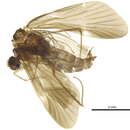Comprehensive Description
provided by Smithsonian Contributions to Zoology
Smicridea (S.) matagalpa
This species is rather widely distributed over the southern half of Central America. It does not show any obvious relationships to the other regional species of the nigripennis group, nor to any known South American species. The paired, decumbent, dorsal processes of the aedeagus, simple divergent ventral processes with small basolateral teeth, and paired central rods are very distinctive.
The broadly U-shaped lateral supports in the vagina, with a series of sclerotized folds capping each arm, produce a distinctive appearance to the internal female genitalia.
ADULT.—Length of forewing 5–5.5 mm. Color black, legs paler basally, head with white hair anteriorly; forewing with 2 transverse white bands, apical fringe white (rarely with white markings lacking) (cf. Figure 20). Male genitalia: Ninth segment with anterior margin produced into a small, narrow lobe. Tenth tergite in lateral aspect rather short, tapering to a pointed and upturned apex; in dorsal aspect very broad basally, tapering to a small, narrowly produced apex. Clasper with basal segment long, inflated apicad; apical segment in dorsal aspect, with tip produced into a point. Aedeagus enlarged basally, open apically; apex with ventral lobe produced into a pair of slightly divergent processes as seen in ventral aspect, each process bearing laterally several small points; dorsolateral margins produced into decumbent pointed lobes, with a pair of central membranous rods. Female genitalia: Ninth segment produced anterolaterally. Vagina with central sclerite nearly rectangular, with a round opening; lateral supports parallel, with anterior margin transverse; with a complex of sclerotized folds posteriad to each arm and a central plate with reflexed lateral margins.
IMMATURE STAGES.—Unknown.
MATERIAL.—Holotype, male: NICARAGUA, MATAGALPA, 5.3 miles E of Matagalpa, 30 July 1967, O. S. Flint, Jr. USNM Type 72701. Paratypes: Same data, 2 6.
HONDURAS: FRANCISCO MORAZAN: Tegucigalpa, 6 October 1917, F. J. Dyar, 1 .
COSTA RICA: CARTAGO: La Suiza, 17 June 1967, Flint and Ortiz, 2 . Tuis, 18 June 1967, Flint and Ortiz, 1 . Turrialba, 22–28 February 1965, S. S. and W. D. Duckworth, 2 . 3 miles W of Turrialba, 18–21 June 1967, Flint and Ortiz, 1 5.
PANAMA: CHIRIQUI: Boquette, 16–17 July 1967, O. S. Flint, Jr., 24 28 . COCLE: El Valle, 15 July 1967, O. S. Flint, Jr., 4 1 . CANAL ZONE: Pipeline Road, Rió Agua Salud, 8–12 July 1967, Flint and Ortiz, 1 . Paraiso, 15 January 1911, A. Busck, l.
BIOLOGY.—All the adults that I have collected were taken at an ultraviolet light. The adjacent streams were usually less than 5 meters wide and tumbling rapidly over a bottom of boulders and gravel.
- bibliographic citation
- Flint, Oliver S., Jr. 1974. "Studies of Neotropical Caddisflies XVII: The Genus Smicridea from North and Central America (Trichoptera: Hydropsychidae)." Smithsonian Contributions to Zoology. 1-65. https://doi.org/10.5479/si.00810282.167

